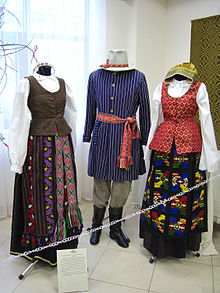Suvalkija
[11] One commentator labeled the effort to rename the region as "neotribalism" – an artificial attempt to find connections with the long-extinct tribe.
[13] They have also argued that the term Suvalkija is a fairly recent and artificial political development, popularized by Soviet historians, and that the more archaic Sudovia more correctly reflects the region's historical roots.
[14] The suffix -ija is not generally used in the Lithuanian language to derive placenames from city names (the only exception is Vilnija, used to describe the Vilnius Region).
Zanavykai occupy northern Suvalkija in the area approximately bounded by the Neman, Šešupė, and Višakis Rivers.
[16] To correct this, linguists proposed naming the group Užnoviečiai or Užnoviškiai, terms which also mean "beyond the Nova river" but follow Lithuanian language precedents.
When linguists classified Lithuanian language dialects, they identified two major sub-dialects in Suvalkija: one in the territory inhabited by Zanavykai and another in the south.
The Commonwealth was partitioned in 1795 and Suvalkija, as part of the larger territory on the left bank of the Neman River, was incorporated into the Province of East Prussia.
In 1807 Suvalkija was briefly part of the Duchy of Warsaw, a small Polish state established by Napoleon Bonaparte, before being incorporated in 1815 into Congress Poland, an entity formed by personal union with the Russian Empire.
The demand for wood experienced a sharp decrease and the Grand Duchy of Lithuania lost almost half of its population due to the Northern Wars (1655–1661), famine, and plague.
Settlers were attracted by its fertile farmland, which had largely been cleared of forests, and by the relative ease of serfdom in the area: because much of the land was owned by the Grand Duke himself, serfs did not have to perform corvée.
The city had become a major trade center and was the second-largest export destination (following Riga, Latvia) of the Grand Duchy.
[24] By the 1820s,[25] farmers in Suvalkija had begun to divide their villages into individual farmsteads (Lithuanian: singular – vienkemis, plural – vienkemiai).
Early abolition of serfdom, fertile land, and close economic ties with East Prussia contributed to Suvalkija's relative wealth.
[32] Suvalkija remains one of the most important agricultural regions of Lithuania, harvesting large crops of sugar beets.
The Teutonic Knights frequently raided the region during the Middle Ages in ongoing attempts to conquer and baptize the pagan Grand Duchy of Lithuania.
Of these impacts, the most important were the introduction of the Napoleonic Code, the usage of the Gregorian Calendar, and the abolition of serfdom almost 50 years earlier than in the rest of Lithuania.
[35] The Revival, which had previously been centered in eastern Samogitia, gradually shifted to Suvalkija due to the activities of these prominent figures and its better economic conditions.
[37] Along a gradient from north (Zanavykai) to south (Kapsai and Dzūkija) the stressed first component of mixed diphthongs ul, um, un, ur, il, im, in, and ir, changes from short to semi-long to long (from kúlt to kùlt to kūlc – to thresh, from pírmas to pìrmas to pyrmas – first, from pínti to pìnti to pync – to braid).
and truncate the past tense form of verbs (žino instead of žinojo – he knew, galė instead of galėjo – he could, ė instead of ėjo – he walked).
Kapsai women wore long, wide dress garments with large designs of stars and tulips, semidark in color and partially striped.
[39] Their aprons were especially richly decorated and colorful,[40] with Kapsai laying stripes and other ornaments horizontally, while the Zanavykai preferred vertical compositions.
[39] As elsewhere, clothing styles began to rapidly change at the beginning of the 20th century as city and town culture increasingly influenced the traditional peasant life.
Women started wearing a variety of jackets, usually of one dark color, and covered their heads with simple scarves tied under their chins.
[41] The shift can be attributed to the relative abundance of original clothing from the region, which was rich in decoration and could compete with the costumes of other European nations.
A number of prominent activists, including President of Lithuania Kazys Grinius and his wife Joana Griuniuvienė, collected and promoted the clothing of Suvalkija, especially aprons and sashes.
[41] At the time regional differences were not emphasized and cultural activists were attempting to arrive at a single model of a "Lithuanian" national dress, based on samples from Suvalkija.
The kanklės, possibly the most archaic Lithuanian instrument, took on distinguishable characteristics in the region; more heavily ornamented than elsewhere, its end is narrow, spreading out into a rounded shape.
[42] Recordings made in the 1930s, and reissued in the 21st century by the Institute of Lithuanian Literature and Folklore, contain waltzes, marches, schottisches, and krakowiaks.
The recordings from this era are monodic; there is usually one singer, and the music relies on variable modal structures, changes of tempo, and subtle ornamentation of the melody for interest.
Later ensembles often included one or two fiddles, a German or Viennese harmonica, a būgnas, and at times a cymbal, a clarinet, a coronet, or a besetle (a stringed bass).



